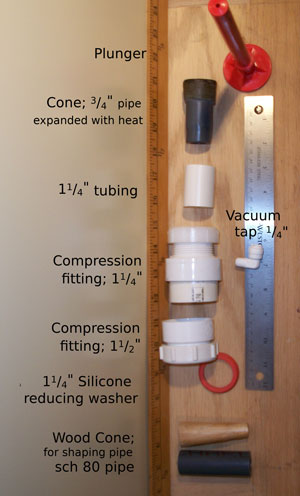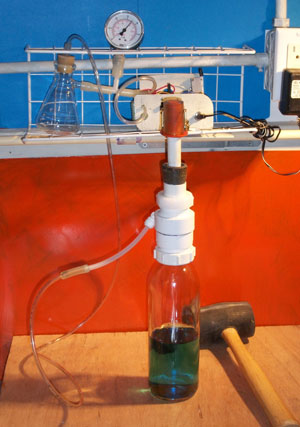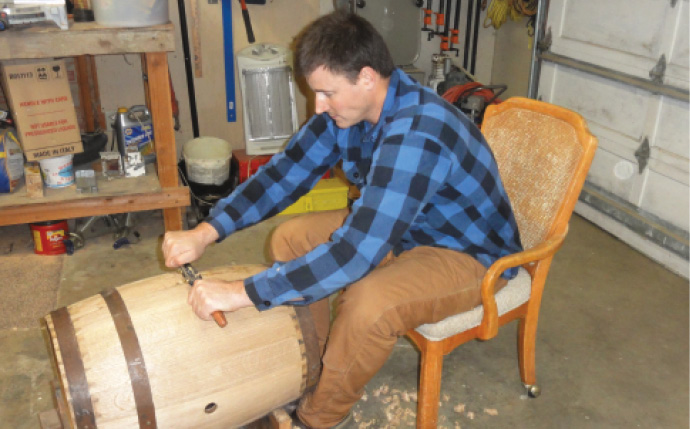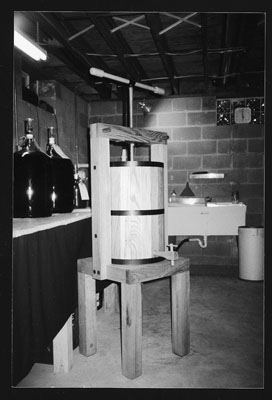The the purpose of this project was to minimize oxygen and achieve longer shelf life on fruit wines. One trick commercial folks use to increase shelf life is packaging under a vacuum. I have been using a vacuum pump for racking wine/ starting a siphon therefore some of the hardware already existed. It looked like it would be easy to produce a home scale vacuum corker.
 Basics: The work which corking tools do is to compress the cork slightly and then push the cork into the bottle. Corks which are available in my local store (Nomacork) are 22 mm diameter by 38 mm high. The neck of a wine bottle typically has an inside diameter of 18.5 mm. Several designs of home style corkers push the cork through a cone to compress it so that it is smaller than the bottle’s opening. The steepest corker cone I have tried is one I call “double lever” going from a 32 mm to a 15 mm diameter in a 70 mm high tube. A fairly shallow design cone is the “mini corker” going from 24 mm to a 18 mm diameter in a 48 mm high tube. My local shop also has a vacuum pump style “wine saver” for preserving open bottles. It applies a hollow cork with a check valve. The wine saver I have will achieve -0.5 atmosphere, technically interesting, but not practical for bottling cases of wine.
Basics: The work which corking tools do is to compress the cork slightly and then push the cork into the bottle. Corks which are available in my local store (Nomacork) are 22 mm diameter by 38 mm high. The neck of a wine bottle typically has an inside diameter of 18.5 mm. Several designs of home style corkers push the cork through a cone to compress it so that it is smaller than the bottle’s opening. The steepest corker cone I have tried is one I call “double lever” going from a 32 mm to a 15 mm diameter in a 70 mm high tube. A fairly shallow design cone is the “mini corker” going from 24 mm to a 18 mm diameter in a 48 mm high tube. My local shop also has a vacuum pump style “wine saver” for preserving open bottles. It applies a hollow cork with a check valve. The wine saver I have will achieve -0.5 atmosphere, technically interesting, but not practical for bottling cases of wine.
Theoretical effect with a bordeaux bottle: the cork occupies 10 mL, ¾ inch of ullage brings the space up to 19 ml, if the ullage goes to the neck (1½ inch ) 26 mL of air exists when the cork is inserted. To saturate 750 ml takes 4.5 to 5 ml (cold takes more) of pure oxygen (but the atmosphere is 20% O2) therefore 22 to 26 ml of ambient air can saturate the wine in a 750 ml bottle. ie when we corked our bottles we may have pushed enough oxygen in to get to 73% to 100% saturated oxygen in the wine. Humm 🙂 did I put enough sulphite in to prevent bottle shock?
This Design: Pressure tight plumbing parts are readily available. This tool was largely built out of PVC pipe fittings. A few years back silicone compression washers became my favorite on hard to seal joints, therefore a silicone washer is used to seal against the bottle. A cork in the top acts as a plug producing a reasonably tight vacuum chamber. The complicated part of the project was that the shape of the neck of bottles varies from a stubby Bordeaux to a tall Champagne shape. A fix to adjust the tool for bottle shape was to glue the cone into 1¼ inch tubing and raise or lower the cone assembly for different types of bottle.
Parts Used: From the bottom up the series consists of: target wine bottle → 1¼ inch silicone slip joint reducing washer → 1½ inch PVC slip joint compression fitting → enough 1½ inch pipe to connect the fittings → 1½ inch pipe to 1¼ inch slip joint compression fitting → nylon washer → 1¼ inch tubing with a cone glued inside. The 1¼ inch tubing extends down and adjusts to touch the mouth of the wine bottle. Once everything was glued together a vacuum tap for ¼ inch tubing was installed off the side of the assembly and connected to the vacuum pump. The final part was a plunger for pushing the cork into the wine bottle.
Construction: A first (easy) method which I debated was to cut the cone out of a “mini corker” and silicone glue it into the 1¼ inch tubing. After looking in the parts shelf I noted that ¾ inch schedule 80 pipe would be ideal at 18.3 mm inside diameter. In the model in the photo ¾ inch PVC pipe was expanded to a 26 mm diameter (1 inch). To do this the end of some scrap ¾ inch pipe was heated to the softening temperature (275 °F/ 135 °C) in a gas flame and then shaped into a short cone by hammering a piece of wood into it. After it cooled the PVC was cut at a convenient length (65 mm/ 25/8 inch), filed round till it would slip inside 1¼ inch tubing, and then glued into said tubing. This tubing was trimmed 2 mm (1/8 inch) longer than the bottom of the cone, creating a slight circle/ target area for the bottle. The finished length of this tubing was 42 mm (1½ inch) which could allow about an inch of adjustment. As finished this cone went from a 26 mm to a 17.5 mm diameter over a 65 mm (2-5/8 inch) high tube. In use the plunger had a stop added to keep from overdoing insertion. “Example cone 2” was tested since schedule 40 PVC cut offs are easier to find. Yes it also reshapes into a cone but the narrow end needed several tries to produce a round shape.
Notes on Operation: A neighbor’s AC pump can pull 17.5 in/Hg (-0.58 atmosphere) of vacuum on a capped pipe. This corking tool seals well enough that I can also pull 17.5 in/Hg of vacuum against a 750 ml bottle. A side benefit of vacuum corking is the corks slide in more easily. Reused Bordeaux bottles from different wineries have some variation in shape. With the nylon top washer it is easy to adjust height on the fly. Vacuum lines and permanent pump installation are quickly connected and disconnected using 20 mm (1 inch) patches of ¼ inch ID silicone tubing.






